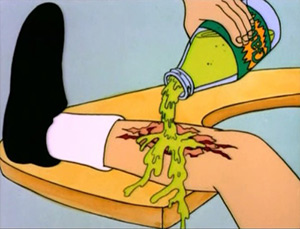health

The present research provides empirical evidence that drug names may entail implicit promises about their therapeutic power. We asked people to evaluate the perceived efficacy and risk associated with hypothetical drug names and other secondary related measures. We compared opaque (without meaning), functional (targeting the health issue that the drug is meant to solve) and persuasive (targeting the expected outcome of the treatment) names. Persuasive names were perceived as more efficacious and less risky than both opaque and functional names, suggesting that names that target the expected outcome of the drug may bias the perception of risk and efficacy.
{ Applied Cognitive Psychology }
oil on canvas { Vincent van Gogh, Skull of a Skeleton with Burning Cigarette , 1886 }
economics, health, marketing | June 18th, 2014 12:19 pm

Just as we can design and install digital apps in our electronic devices, we can design and install mindapps in our minds. For philosophy the big-problem is the hegemonic assumption that all good thinking takes place in our ordinary, default mindbody state—wakefulness. Because of this error, the vast extensions of our minds beyond our default state are neglected, and directions for future mind development are stunted, if not outright denied. Multistate theory releases that constriction. By reformulating our minds as variables for experimental philosophy, multistate theory re-asks philosophical questions, extends current issues, and engenders fun speculations. Because psychedelics are the most dramatic example of widely known mindbody psychotechnologies, we will illustrate multistate theory with psychedelics’ contributions
{ Thomas B. Roberts | Continue reading }
drugs, ideas | June 13th, 2014 7:39 am

Damage to certain parts of the brain can lead to a bizarre syndrome called hemispatial neglect, in which one loses awareness of one side of their body and the space around it. In extreme cases, a patient with hemispatial neglect might eat food from only one side of their plate, dress on only one side of their body, or shave or apply make-up to half of their face, apparently because they cannot pay attention to anything on that the other side.
Research published last week now suggests that something like this happens to all of us when we drift off to sleep each night.
{ Neurophilosophy/Guardian | Continue reading }
art { Andy Warhol, Mrs. McCarthy and Mrs. Brown (Tunafish Disaster), (1963) }
brain, sleep, warhol | June 9th, 2014 1:01 pm

For all those brunettes wishing they were naturally blond, a small genetic change could have made all the difference. Scientists have found that replacing one of DNA’s four letters at a key spot in the genome shifts a particular gene’s activity and leads to fairer hair. Not only does the work provide a molecular basis for flaxen locks, but it also demonstrates how changes in segments of DNA that control genes, not just changes in genes themselves, are important to what an organism looks like. […]
Over the past 6 years, studies of genetic variation in thousands of people have linked at least eight DNA regions to blondness based on the fact that a certain DNA letter, or base, was found in people with that hair color but not in people with other hair colors. Some of those base changes, or single-nucleotide polymorphisms (SNPs), were in genes involved in the production of pigments, such as melanin. Mutations in these genes typically change skin and hair color. Other SNPs lay outside genes but could be part of the regulatory DNA that helps control the function of genes nearby. Changes in that regulatory DNA could result in hair color but not skin color change, or vice versa, because regulatory DNA can change gene activity in just certain parts of the body.
{ Science | Continue reading }
related { Smokers with gene defect have one in four chance of developing lung cancer }
genes, hair | June 2nd, 2014 7:23 am

Gelignite, or blasting gelatin, is a mixture of nitroglycerin, gun cotton, and a combustible substance like wood pulp. It resembles dynamite (also invented by Alfred Nobel) but can be conveniently molded into shape with the bare hands.
The October 6, 1904 issue of Russian Doctor contained a dispatch about a young woman who “found a cartridge containing this substance in her husband’s trunk and ate it, taking the cartridge for a piece of confectionery.” Despite her husband’s fears, she neither exploded nor expired from the effects of the poison, as summarized in the New York Medical Journal six weeks later.
{ Improbable | Continue reading }
art { Francis Bacon, Portrait of Isabel Rawsthorne, 1966 }
Francis Bacon, poison, science | June 1st, 2014 7:00 am

The brain systems that modulate “that loving feeling” are only just beginning to be understood, but neuroscience research is pointing more and more to the idea that the sensation of love relies on the same brain circuitry that goes awry in addiction. Love is a drug, basically — because only a drive as strong as an addiction could keep couples together through the stresses of parenting and keep parents tied to their kids.
Research has found, for example, that people in love are similar to those suffering from obsessive-compulsive disorder — not only in terms of their obsessive thinking and compulsive behavior, but also the low levels of the neurotransmitter serotonin in their blood. So in a sense, love may be a special case of addiction
“The bottom line is that a lot of data on people rejected in love show that the major pathways linked with addiction become activated,” says Helen Fisher, a biological anthropologist at Rutgers University. If love is a drug, however, love’s chemistry can be chemically manipulated — those who are in love but don’t want to be could potentially take a pill that simply makes the formerly loved one seem no more special than a stranger.
{ NY mag | Continue reading }
“Love hurts”—as the saying goes—and a certain amount of pain and difficulty in intimate relationships is unavoidable. Sometimes it may even be beneficial, since adversity can lead to personal growth, self-discovery, and a range of other components of a life well-lived.
But other times, love can be downright dangerous. It may bind a spouse to her domestic abuser, draw an unscrupulous adult toward sexual involvement with a child, put someone under the insidious spell of a cult leader, and even inspire jealousy-fueled homicide. […]
Modern neuroscience and emerging developments in psychopharmacology open up a range of possible interventions that might actually work. These developments raise profound moral questions about the potential uses—and misuses—of such anti-love biotechnology. In this article, we describe a number of prospective love-diminishing interventions, and offer a preliminary ethical framework for dealing with them responsibly should they arise.
{ Taylor Francis Online | Continue reading }
drugs, neurosciences, psychology, relationships | May 20th, 2014 12:09 pm

Resveratrol, a polyphenol found in grapes, red wine, chocolate, and certain berries and roots, is considered to have antioxidant, anti-inflammatory, and anticancer effects in humans and is related to longevity in some lower organisms.
Objective: To determine whether resveratrol levels achieved with diet are associated with inflammation, cancer, cardiovascular disease, and mortality in humans.
Results: Resveratrol levels achieved with a Western diet did not have a substantial influence on health status and mortality risk of the population in this study.
{ JAMA | Continue reading }
Red wine may not be as good for you as hoped, say scientists who have studied the drink’s ingredient that is purported to confer good health.
{ BBC | Continue reading }
food, drinks, restaurants, health | May 20th, 2014 10:34 am

The US National Institute for Mental Health (NIMH) said the DSM-5 (Diagnostic and Statistical Manual of Mental Disorders) had so many problems we effectively need to tear it up and start again. The way forward, it said, is a new research programme to discover the brain problems that underlie mental illnesses.
That research is now taking off. The first milestone came earlier this year, when the NIMH published a list of 23 core brain functions and their associated neural circuitry, neurotransmitters and genes – and the behaviours and emotions that go with them (see “The mind’s 23 building blocks”). Within weeks, the first drug trials conceived and funded through this new programme will begin. […]
Criticism of psychiatry has been growing for years – existing treatments are often inadequate, and myriad advances in neuroscience and genetics have not translated into anything better. Vocal opponents are not confined to the US. Last week, the new UK Council for Evidence-based Psychiatry launched a campaign claiming that drugs such as antidepressants and antipsychotics often do more harm than good.
What’s more, many suspect that commonly used labels, such as depression and schizophrenia, merely group together people sharing some superficial symptoms, when their underlying brain disorders are quite different.
Genetic studies, for instance, suggest that schizophrenia and bipolar disorder, supposedly distinct conditions, involve mutations in many of the same genes. And diagnostic confusion between the disorders is common. […]
So what do the mind’s 23 building blocks consist of? The best mapped-out anatomically is the brain’s fear circuitry, thanks to years of scaring volunteers as they lie in fMRI scanners. This system is probably involved in phobias and post-traumatic stress disorder.
Another is the related circuitry that deals, not with present danger, but with vaguer fears that something bad might happen in future. “That circuit is very relevant to rumination and anxiety,” says Cuthbert.
Another five neural systems are components of the brain’s reward circuitry, which is active when we find something pleasurable – like eating or sex – and drives us to repeat the experience. These can malfunction when people are addicted to drugs or alcohol.
The reward system, says Cuthbert, is very powerful because one of the most important things that organisms need to learn is to seek out things like food and water. “Drug abuse hijacks that system so the cues create urges that are very hard to resist,” he says.
{ NewScientist | Continue reading }
health, neurosciences, psychology | May 11th, 2014 3:29 pm

It was only a few decades ago that incision and suction were recommended snakebite first aid. However, concerns arose about injuries and infections caused when laypersons made incisions across fang marks and applied mouth suction. Meanwhile, several snakebite suction devices (eg, Cutter’s Snakebite Kit, Venom Ex) were evaluated, and it was determined that they were neither safe nor effective. So, recommendations changed, and mechanical suction without incision was advocated instead. It seemed intuitive that suction alone would probably remove venom and should not cause harm. However, when the techniques were studied rigorously, quite the opposite was discovered.
One of the most popular suction devices, the Sawyer Extractor pump (Sawyer Products, Safety Harbor, FL), operates by applying approximately 1 atm of negative pressure directly over a fang puncture wound (or wounds) without making incisions. […] Although each of these 3 studies was done independently of each other and using different methodology, they arrive at the same conclusion: the Extractor does not work, and it could make things worse.
{ Annals of Emergency Medecine | PDF }
health, poison, reptiles | May 7th, 2014 10:40 am

In humans, as in many other animals, the appetite prioritizes protein over carbohydrate or fat. The evolutionary explanation is straightforward: eating too little protein compromises growth, development and reproduction.
Many processed food products are protein-poor but are engineered to taste like protein. Many people therefore eat far too much fat and carbohydrate in their attempt to ingest enough protein. In this way, engineered foods subvert the appetite control systems that should be helping to balance the consumption of macronutrients. The results are striking. In the United States, the typical diet saw a 0.8% decline in protein concentration between 1971 and 2006. During this same period, the consumption of calories from carbohydrates and fats increased by 8%, a trend reflected in the rising prevalence of obesity, but protein intake remained almost unchanged.
{ Nature | Continue reading }
economics, food, drinks, restaurants, health | April 18th, 2014 5:49 am

Vein geometry is just as unique as irises and fingerprints. The serpentine network of your vascular system is determined by many factors, including random influences in the womb. The result is a chaotic, singular print. Even twins have different vein structure in their hands. Vein patterns don’t change much as you age, so a scan of your palm can serve as biometric identification for the rest of your life.
{ Quartz | Continue reading }
blood, technology | April 15th, 2014 2:59 pm

Ketamine, a chemical used as an anaesthetic for horses and as an illegal party drug, can produce “remarkable changes” in severely depressed patients who are not helped by existing treatments, according to a new study.
Oxford university researchers reported encouraging results from a clinical trial in the Journal of Psychopharmacology. Some patients who had been severely depressed for years, despite multiple antidepressants and talking therapies, responded rapidly to intravenous infusions of ketamine.
[…]
The Oxford team has given more than 400 ketamine infusions to 45 patients and is now looking for ways to sustain the initial benefits, which faded in most of the patients.
Although ketamine is a banned substance – and about to be upgraded by the Home Office from Class C to Class B – the Oxford patients did not show the ill effects, such as bladder problems and memory loss, which make it a dangerous drug of abuse.
The doses used to treat depression are much lower than some people take illegally. Even so, most patients experienced a shortlived “dissociative” effect, with feelings that they were disconnecting from their body, as the drug was being infused. It did not produce euphoric feelings.
{ FT | Continue reading }
drugs | April 3rd, 2014 2:49 pm
health | March 27th, 2014 11:56 am
haha, hair, health, photogs | March 21st, 2014 3:11 pm

The most striking finding of our study is that addition of milk to black tea completely prevents the biological activity of tea in terms of improvement of endothelial function. Our results thus provide a possible explanation for the lack of beneficial effects of tea on the risk of heart disease in the UK, where milk is usually added to tea.
{ European Heart Journal | PDF }
and { Happy people work harder (especially if they get chocolate) }
art { Barnett Newman, The Voice, 1950 }
food, drinks, restaurants, health | March 21st, 2014 11:20 am

In a survey of more than 1,300 adults, 20% agreed with the theory that childhood vaccines cause autism. Far fewer believed that the U.S. government hatched a plot to infect African Americans with HIV. Overall, 49% agreed with at least one of the six conspiracy theories presented.
{ NY Daily News | Continue reading }
health | March 21st, 2014 11:13 am
health, kids, weirdos | March 11th, 2014 6:28 am

A 30,000-year-old giant virus has been revived from the frozen Siberian tundra, sparking concern that increased mining and oil drilling in rapidly warming northern latitudes could disturb dormant microbial life that could one day prove harmful to man.
The latest find, described online Monday in the Proceedings of the National Academy of Sciences, appears to belong to a new family of mega-viruses that infect only amoeba. But its revival in a laboratory stands as “a proof of principle that we could eventually resurrect active infectious viruses from different periods,” said the study’s lead author, microbiologist Jean-Michel Claverie of Aix-Marseille University in France.
{ LA Times | Continue reading }
photo { John Gutmann, I am the Magic Hand, 1937 }
health, horror | March 4th, 2014 9:35 am

Almost half of all disturbing dreams contain primary emotions other than fear, study finds […]
The research also found that men and women tend to have different dreams. Men were “significantly” more likely to report themes involving disaster or calamity as well as insects while women’s dreams were more likely to feature interpersonal conflicts.
{ Telegraph | Continue reading }
related { Use what hotels know about sleeping to build your own dreamland }
genders, psychology, sleep | February 19th, 2014 12:55 pm

In two studies, we examine the effect of manipulating the position of different foods on a restaurant menu. Items placed at the beginning or the end of the list of their category options were up to twice as popular as when they were placed in the center of the list. Given this effect, placing healthier menu items at the top or bottom of item lists and less healthy ones in their center (e.g., sugared drinks vs. calorie-free drinks) should result in some increase in favor of healthier food choices.
{ Judgment and Decision Making | Continue reading }
food, drinks, restaurants, health, psychology | February 17th, 2014 12:07 pm






















